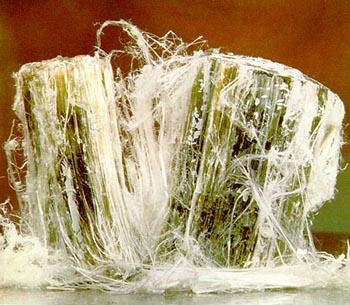Chrysotile is a sheet silicate which is formed as a very thin rolled sheet. The sheet is about 8 angstoms thick (0.8 nanometers thick). It is composed of a sandwich of magnesium and silica. In the lung, the acid environment of the macrophage scavenger cell quickly breaks apart the sheet structure causing the fiber to decompose into small pieces. These pieces can then be readily cleared from the lung. If the fiber is swallowed and ingested it is attacked by the even stronger acid environment (hydrochloric acid, PH 2) in the stomach.
Chrysotile has been known for over 2000 years, being used initially for cremation cloths, oil lamp wicks and other textiles. But, it is only in the 19th Century that Chrysotile was first mined commercially in the Urals (Russia), Italy and Canada.
Only high-density chrysotile products are manufactured and sold today. The unique feature of these products is that the chrysotile fibre is encapsulated in a matrix of cement or resin, preventing the release of fibres. Over 90% of chrysotile used worldwide today is in the manufacture of fibre-cement building and construction materials.
Products: Chrysotile-cement, friction, high density and fibre.
Chrysotile-cement products: more than 90% of the world production of chrysotile is used in the manufacture of chrysotile-cement, in the form of pipes, sheets and shingles. These products are used in some sixty industrialized and developing countries. Chrysotile-cement is valued principally for its excellent cost effectiveness and durability. Manufacture of this material requires the import of only small quantities of fibre, the other raw materials being easily available locally. Moreover, the manufacturing technology requires little investment and consumes less energy than production methods for competing products.
Friction materials: because of its natural resistance to heat, chrysotile fibres have been widely used in friction materials. Automobile brake shoes, disk pads, clutches and elevators brakes are common examples of products using chrysotile fibre.
Other products: as reported in several books, chrysotile was used in the manufacturing of some 3000 products. The reality today is simpler, but there is still a significant variety of common-day and industrial uses of chrysotile containing products. For example, chrysotile fibre is used in roof sealants, textiles, plastics, rubbers, door seals for furnaces, high temperature caulking, paper, components for the military and the nuclear industry.
Hazards and risks of chrysotile and risk management on World and European level
Chrysotile asbestos is recognized by every leading world scientific body as a cause of asbestosis, lung cancer and mesothelioma, as have all other forms of commercially used asbestos that are currently listed on the PIC List (Prior Informed Consent (PIC) list) of hazardous substances belonging to the United Nations Rotterdam Convention. Chrysotile is not on the PIC list, because some countries (India, Russia, etc.) opposed its inclusion.
Although the chrysotile asbestos industry argues that chrysotile asbestos is safe, the World Health Organization (WHO) states that all forms of asbestos are carcinogenic to humans and may lead to mesothelioma and lung, larynx, and ovarian cancer. WHO estimates that 107,000 workers die every year from asbestos-related lung cancer, mesothelioma and asbestosis. One in every three deaths from occupational cancer is caused by asbestos.
In accordance with Entry 6 of Annex XVII of Regulation (EC) No 1907/2006 of the European Parliament and of the Council on the Registration, Evaluation, Authorisation and Restriction of Chemicals (REACH), the manufacture, placing on the market and use of asbestos fibres and of articles containing these fibres added intentionally is prohibited. This entry lists 6 types of asbestos: chrysotile, crocidolite, amosite, anthophyllite, tremolite and actinolite.
According to paragraph 1 of Entry 6, Member States may exempt the placing on the market and use of diaphragms containing chrysotile for existing electrolysis installations until they reach the end of their service life, or until suitable asbestos-free substitutes become available, whichever is the sooner.
Paragraph 2 specifies that Member States may allow placing on the market of articles in their entirety containing asbestos fibres referred to in paragraph 1 which were already installed and/or in service before 1 January 2005, under specific conditions ensuring a high level of protection of human health.
As regards exemptions granted in line with paragraph 1, Member States had to provide a report to the Commission by 1 June 2011 on:
- the availability of asbestos-free substitutes for electrolysis installations and the efforts undertaken to develop such alternatives,
- the protection of workers' health in the installations,
- the source and quantities of chrysotile,
- the source and quantities of diaphragms containing chrysotile, and
- the envisaged date of the end of the exemption.
As regards the exemption granted in line with paragraph 2, Member States had to communicate the national measures to the Commission by 1 June 2011.
With the present report, the Commission makes publicly available the information communicated by Member States according to the entry 6 of Annex XVII of REACH. Report ![]() .
.
In compliance with the provision in paragraph 1 of entry 6 of Annex XVII of REACH, the Commission has requested the European Chemicals Agency to prepare a dossier in accordance with Article 69 of REACH with a view to prohibit the placing on the market and use of diaphragms containing chrysotile. Request letter to ECHA ![]() .
.
Safe use of chrysotile, demonstrated by photos on the website of the Chrysotile Institute.
| Transport and Warehousing | 1 - 2 - 3 |
| Debagging operations | 4 - 5 - 6 |
| The Manufacturing Process | 7 - 8 - 9 |
| Factory cutting | 10 |
| Waste Management and Recycling | 11 - 12 |
| On Site Installation | 13 - 14 |
| The controlled-use approach | 15 |
http://www.chrysotileassociation.com/en/chrysotile/overview/default.php
http://ec.europa.eu/enterprise/sectors/chemicals/reach/restrictions/asbestos-exemptions_en.htm
http://www.asbestosdiseaseawareness.org/archives/21214
